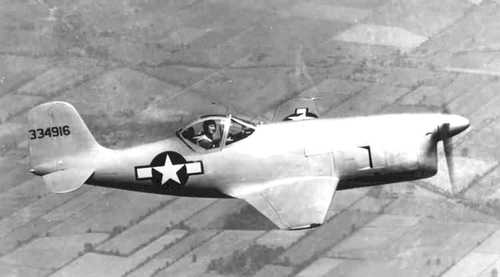
US Army Air Force
Bell XP-77 - one that didn't make it.
US Army Air Force.
Rare photo of a Bell XP-77-1 in flight. Only two prototype model were produced and tested between April and December, 1944, at which time the programme was discontinued. Shortly before the USA entered the war, the United States Army Air Force issued a request for proposals for the construction of a new light fighter/interceptor making maximum use of "non-strategic" materials. The Bell Aircraft Corporation responded with a proposal (in October, 1941) for what promised to be a lightweight, but quite hard-hitting fighter, the "non-strategic" element of which was that its body would be constructed largely from wood. Based on the experience of 1930s racing monoplanes, it was thought that this would enable the production of a high-performance fighter at light weight and relatively low cost. Armament was projected as one 20mm nose-mounted cannon and two .50 machine guns (with bomb or depth charge alternatives to the machine guns). Landing gear would have been of "tripod" form with a nose-mounted third wheel, a model found successful on the Aircobra. The programme was bedeviled by problems from the start, problems of a nature that (bearing in mind the history of the Aircobra's development) might be described as "typically Bell". Weight was a persistent problem. In spite of the wooden body, it proved impossible to meet the required weight specifications, a factor that impacted directly on potential performance. There was also the question of powerplant. A new engine - the Ranger XV-770-9 12-cylinder engine with supercharger - was plagued by development delays, resulting in this proposal being, not dropped, but put to one side in favour of the less powerful, non-supercharged XV-770-7. Also, Bell's attempt to address, at least in part, the weight problem by outsourcing the construction of the wooden bodies to specialist subcontractors was not successful, and merely complicated the project. The prospects of correcting these difficulties were further reduced by the inability of the Bell Corporation to direct the necessary resources towards the project in view of the heavy demands on production and ongoing development of their successful design, the Aircobra, supplies of which were in heavy demand from both the USAAF and the Soviet Air Force. Eventually, two experimental prototype/pre-production aircraft were produced and evaluated by the USAAF between April and December, 1944. This evaluation proved less than satisfactory. Apart from the restriction on forward view imposed by the aircraft's rearward cockpit and long nose (necessary to accommodate the forward-mounted engine), it suffered from engine vibration problems and, overall, proved difficult to fly and poor in performance, in spite of being flown without armament. The unfortunate "highlight" of the evaluation process occurred when one of the prototypes, attempting an "Immelmann Turn" (a sort of diving-climbing-diving U-turn associated with WW1 German ace Max Immelmann), spun out of control and crashed. Fortunately, the pilot managed to bail out. No doubt influenced by the state of the war, the USAAF declared itself no longer to be interested in the doomed project, in December, 1944. Best regards, JR.
2877 Views
4/9/2014
